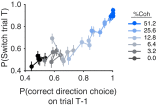Hierarchical decision processes that operate over distinct timescales underlie choice and changes in strategy
- PMID: 27432960
- PMCID: PMC4978308
- DOI: 10.1073/pnas.1524685113
Hierarchical decision processes that operate over distinct timescales underlie choice and changes in strategy
Abstract
Decision-making in a natural environment depends on a hierarchy of interacting decision processes. A high-level strategy guides ongoing choices, and the outcomes of those choices determine whether or not the strategy should change. When the right decision strategy is uncertain, as in most natural settings, feedback becomes ambiguous because negative outcomes may be due to limited information or bad strategy. Disambiguating the cause of feedback requires active inference and is key to updating the strategy. We hypothesize that the expected accuracy of a choice plays a crucial rule in this inference, and setting the strategy depends on integration of outcome and expectations across choices. We test this hypothesis with a task in which subjects report the net direction of random dot kinematograms with varying difficulty while the correct stimulus-response association undergoes invisible and unpredictable switches every few trials. We show that subjects treat negative feedback as evidence for a switch but weigh it with their expected accuracy. Subjects accumulate switch evidence (in units of log-likelihood ratio) across trials and update their response strategy when accumulated evidence reaches a bound. A computational framework based on these principles quantitatively explains all aspects of the behavior, providing a plausible neural mechanism for the implementation of hierarchical multiscale decision processes. We suggest that a similar neural computation-bounded accumulation of evidence-underlies both the choice and switches in the strategy that govern the choice, and that expected accuracy of a choice represents a key link between the levels of the decision-making hierarchy.
Keywords: adaptive behavior; confidence; executive control; hierarchical decision-making; perceptual decision-making.
Conflict of interest statement
The authors declare no conflict of interest.
Figures












References
-
- Logan GD, Gordon RD. Executive control of visual attention in dual-task situations. Psychol Rev. 2001;108(2):393–434. - PubMed
Publication types
MeSH terms
Grants and funding
LinkOut - more resources
Full Text Sources
Other Literature Sources
Research Materials

